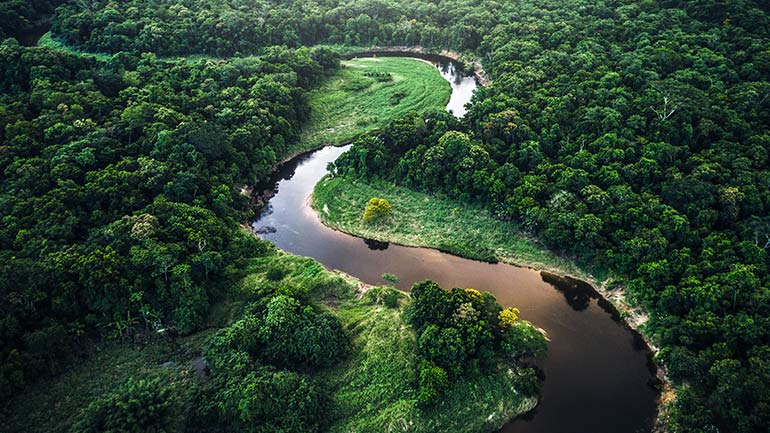The Route to Delivering the Negative Emissions Market
July 12, 2022
-
4 Minutes

Negative Emissions Technologies (NETs) are the next frontier. As corporations and governments continue on their paths to net zero, emission reductions are no longer enough. Removing harmful greenhouse gases (GHGs) from the atmosphere is a necessary step – one that the latest Intergovernmental Panel on Climate Change (IPCC) report called "unavoidable". NETs, also referred to as Greenhouse Gas Removal (GGR) technologies, help balance out the processes and sectors that are difficult to decarbonize entirely.
The fervor around NETs has reached an all-time high in the minds of corporations, policy makers, and investors. The First Movers Coalition announced at COP26 has since received more than US$10B in commitments from 50 companies and nine governments to support new technologies including NETs. As such, it was a prevalent topic throughout our recent Global Clean Technology & Energy Transition Virtual Conference, a three-day event featuring insights from leaders across the clean technology and energy sectors.
Susan Thompson, Director of Sustainable Finance & Corporate Transitions, shares some of the key themes observed across the conference on delivering the negative emissions market:
The fervor around NETs has reached an all-time high in the minds of corporations, policy makers, and investors. The First Movers Coalition announced at COP26 has since received more than US$10B in commitments from 50 companies and nine governments to support new technologies including NETs. As such, it was a prevalent topic throughout our recent Global Clean Technology & Energy Transition Virtual Conference, a three-day event featuring insights from leaders across the clean technology and energy sectors.
Susan Thompson, Director of Sustainable Finance & Corporate Transitions, shares some of the key themes observed across the conference on delivering the negative emissions market:
Current technologies and the importance of permanence
Our panelists agreed that most important step on the path to net zero is to have a decarbonization plan in place; however, these plans may take time to implement and become technologically achievable and affordable. New technologies, such as NETs, offer an interim solution for companies to be net zero in the near term, while for others, especially those in hard to abate sectors, NETs provide the opportunity to completely decarbonize.
NETs help remove carbon from the atmosphere and can be achieved through many avenues – from naturally occurring phenomena to chemically-engineered processes. No matter the approach, our conference panelists emphasized the importance of setting high, robust standards for measuring negative emissions. One critical metric is permanence, the ability to keep emissions out of the atmosphere for a reasonable length of time as CO2 does not completely disintegrate. The success of a GGR solution is, in part, measured by how well (and how long) it keeps CO2 captured or stored.
Some solutions have a high degree of permanence. One example is Direct Air Capture (DAC) technology, which captures CO2 from the atmosphere and stores it in geological formations or uses it, for example, in carbon neutral gas production1. DAC technology has the potential to play a critical role in climate change mitigation, becoming a significant focus for policy makers. As part of their recent Greenhouse Gas Offset Credit System, the Government of Canada identified the next round of protocols to develop, including a protocol on Direct Air Carbon Capture and Sequestration. While the technology has a high level of permanence, it currently comes at a high cost.
NETs help remove carbon from the atmosphere and can be achieved through many avenues – from naturally occurring phenomena to chemically-engineered processes. No matter the approach, our conference panelists emphasized the importance of setting high, robust standards for measuring negative emissions. One critical metric is permanence, the ability to keep emissions out of the atmosphere for a reasonable length of time as CO2 does not completely disintegrate. The success of a GGR solution is, in part, measured by how well (and how long) it keeps CO2 captured or stored.
Some solutions have a high degree of permanence. One example is Direct Air Capture (DAC) technology, which captures CO2 from the atmosphere and stores it in geological formations or uses it, for example, in carbon neutral gas production1. DAC technology has the potential to play a critical role in climate change mitigation, becoming a significant focus for policy makers. As part of their recent Greenhouse Gas Offset Credit System, the Government of Canada identified the next round of protocols to develop, including a protocol on Direct Air Carbon Capture and Sequestration. While the technology has a high level of permanence, it currently comes at a high cost.

There are also nature-based solutions, which offer a less expensive and more immediate solution, but permanence can be a challenge. Nature-based solutions include soil carbon sequestration, planting trees, and mangrove swamps, which accelerate naturally occurring processes that effectively capture CO2. However, there are no guarantees that captured CO2 won't be released down the line, calling the permanence of nature-based alternatives into question. One of our conference panelists pointed to the example of afforestation: planting trees offers a relatively quick, high-impact solution to capturing CO2, but it is not always possible to guarantee the forest will remain intact years down the road. Wildfires, for example, can quickly release all the trapped carbon. That means technological carbon removal solutions, like DAC, will be necessary to compensate for emissions, especially from hard-to-abate sectors.
Bioenergy technology, commonly referred to as Bioenergy with Carbon Capture and Storage (BECCS), captures energy from plant-based materials (e.g. from burning wood pellets) and stores the produced CO2 deep in the ground. This type of technology falls somewhere in between the previously mentioned solutions in terms of permanence and affordability.
Bioenergy technology, commonly referred to as Bioenergy with Carbon Capture and Storage (BECCS), captures energy from plant-based materials (e.g. from burning wood pellets) and stores the produced CO2 deep in the ground. This type of technology falls somewhere in between the previously mentioned solutions in terms of permanence and affordability.
New challenges and opportunities for investors
Investors are eager to learn more about NETs, and all the associated challenges and opportunities. Another major consideration is the cost and scalability of these emerging technologies. The price of carbon is typically lower than the price of carbon capture, utilization and storage (CCUS) per tonne. If these technologies cannot pay for themselves, they will not be able to secure sufficient investment to deliver needed impact at scale. As CCUS and GGR technologies scale, more capital will flow into these projects, making the risks far more manageable and attracting even more capital.
Long-term regulatory support is also a critical consideration for investors. While solutions like afforestation may offer immediate environmental impact, without the proper legal or regulatory structures in place to ensure benefits are protected for the long run, that impact may be short-lived. As the regulatory infrastructure around carbon capture grows, so does the potential for impact and new revenue streams on the path to net zero emissions.
1Source: https://www.iea.org/reports/direct-air-capture
Long-term regulatory support is also a critical consideration for investors. While solutions like afforestation may offer immediate environmental impact, without the proper legal or regulatory structures in place to ensure benefits are protected for the long run, that impact may be short-lived. As the regulatory infrastructure around carbon capture grows, so does the potential for impact and new revenue streams on the path to net zero emissions.
1Source: https://www.iea.org/reports/direct-air-capture

Director, ESG Solutions, TD Securities

Director, ESG Solutions, TD Securities

Director, ESG Solutions, TD Securities

